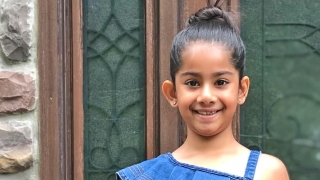Bela’s Story: Robot-assisted Ureteroureterostomy for Duplex Kidney
Published on
Published on
Chirag is an adult pulmonary and critical care doctor whose patients often need lifesaving care. And when he looks back on the care his 7-year-old daughter, Bela, has received at Children’s Hospital of Philadelphia, even he is amazed.
 Bela’s care journey began while she was still in her mother’s womb. At the 20-week ultrasound visit — the much-anticipated milestone during pregnancy when Bela’s parents, Sima and Chirag, were going to actually see their baby for the first time — they learned something wasn’t quite right. The obstetrician near their home in Morristown, N.J., detected low amniotic fluid around the fetus. The OB couldn’t pinpoint the exact problem, so she referred the family to the Center for Fetal Diagnosis and Treatment at Children’s Hospital of Philadelphia.
Bela’s care journey began while she was still in her mother’s womb. At the 20-week ultrasound visit — the much-anticipated milestone during pregnancy when Bela’s parents, Sima and Chirag, were going to actually see their baby for the first time — they learned something wasn’t quite right. The obstetrician near their home in Morristown, N.J., detected low amniotic fluid around the fetus. The OB couldn’t pinpoint the exact problem, so she referred the family to the Center for Fetal Diagnosis and Treatment at Children’s Hospital of Philadelphia.
During a full-day evaluation, the center’s fetal imaging specialists carefully analyzed every detail of Bela’s anatomy. Normally, humans have two ureters, one from each kidney, which drain urine into the bladder. The imaging specialists at CHOP found that Bela’s right kidney actually had two ureters, a condition known as duplex kidney. The condition was causing a significant buildup of urine in the kidney, known as hydronephrosis.
After the evaluation, Sima and Chirag met with the full care team — which included pediatric urologist Arun Srinivasan, MD — to discuss the diagnosis and treatment plan. The plan was to have weekly follow-up appointments for the remainder of the pregnancy to monitor amniotic fluid levels and then surgically correct the anomaly after birth.
That regular monitoring proved vital when a follow-up ultrasound at 27 weeks showed a sudden decrease in amniotic fluid caused by a ureterocele, a condition in which the end of the ureter swells like a balloon. The swelling stopped the flow of urine out of Bela’s bladder and brought her amniotic fluid level dangerously low. Left untreated, the condition can damage the developing kidney and cause premature birth.
The care team, including skilled obstetrician, Mark P. Johnsons, MD, MS, deftly performed the procedure to puncture the ureterocele so the bladder could drain. In fact, Bela ultimately required two procedures in utero, which helped prolong Sima’s pregnancy to 37 weeks.
Bela was born in CHOP’s Garbose Family Special Delivery Unit (SDU) — the world’s first delivery unit in a freestanding children’s hospital created for healthy mothers carrying babies diagnosed with congenital anomalies. The SDU team stabilized Bela and then transitioned her care to Dr. Srinivasan and his urology team.
“It was seamless,” says Chirag of the transition of care. “In medicine, there are so many different disciplines, but at CHOP, it felt like one team.”
Bela underwent a surgical procedure to definitively correct the ureterocele and, after two weeks recovering in CHOP’s Harriet and Ronald Lassin Newborn/Infant Intensive Care Unit (N/IICU), she was discharged home.
She returned to CHOP for follow-up appointments/ultrasounds with Dr. Srinivasan every three months. When Bela was 4 years old, Dr. Srinivasan performed a robot-assisted ureteroureterostomy, a minimally invasive surgical procedure to connect the two portions of her ureter.
“Even as a physician, I am mesmerized by what they were able to do,” says Chirag of CHOP’s care team. “It’s just been phenomenal. She has two tiny little scars. You can barely see them. She’s a normal child. When it’s your child, it’s so difficult to remain calm. But Dr. Srinivasan never let us worry. Our experience at CHOP is something we’ll never forget.”
 Now, two years after surgery, Bela’s kidney function is normal. She still returns to CHOP for follow-up appointments, but they occur yearly now, and Dr. Srinivasan is always pleased with her kidney health.
Now, two years after surgery, Bela’s kidney function is normal. She still returns to CHOP for follow-up appointments, but they occur yearly now, and Dr. Srinivasan is always pleased with her kidney health.
“I feel so comforted by the team,” says Chirag. “I’ve known Dr. Srinivasan longer than I’ve known my daughter. We feel like part of the family.”
“You always have to question the paradigm, and I think that’s what makes CHOP great,” adds Chirag. “They never stop asking what if, why not, and they truly put the family in the forefront. I don’t think I ever finished a visit there without a clear plan and having all of our questions answered. When we left, we felt confident. We never left without certainty.”